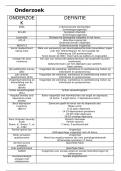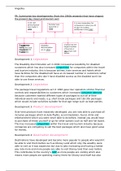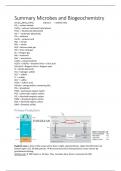Robert Weis
Fourth Edition
2021
Hoofdstuk 1 2
Hoofdstuk 6 4
Hoofdstuk 8 8
Hoofdstuk 9 13
Hoofdstuk 10 19
Hoofdstuk 11 24
Hoofdstuk 12 32
Hoofdstuk 13 38
Hoofdstuk 14 47
Hoofdstuk 15 55
1
,Hoofdstuk 1: The Science and practice of abnormal child psychology
1.1. Identifying behavior problems in children
- Professionals disagree about the best way to deinfe abnormal behavior in children and differentiate it
from normal childhood functioning
- Three features of abnormality include:
1. Statistical deviation or infrequency
2. Disability or impairment
3. Distress
- Jerome Wakefield proposed the harmful dysfunction definition of abnormal behavior. A behavior is
abnormal if it reflects an underlying dysfunction in a biological or psychological system and it causes
disability or distress
How Does DMS-5 Define abnormality
- According to DSM-5, a mental disorder reflects a biological, developmental, or psychological
dysfunction that causes disability or distress in the individual. This definition borrows from Wakefield’s
notion of a harmful dysfunction.
- DMS-5 adopts a medical approach to mental disorders
- The medical approach is limited when applied to children and adolescents because:
1. We can not always identify the underlying cause of children’s disorders
2. Many childhood disorders are best understood in an interpersonal context rather than existing only
within the child
3. Behavior is the best understood in term of their social-culture surroundings
How do psychologists diagnose mental health problems in children?
- DSM-5 uses a categorical approach to classification because it requires children to meet specific
criteria to be diagnosed with a disorder. Youths who do not meet all criteria are not diagnosed with the
disorder
- DMS-5 also uses a prototypical approach to classification for many disorders. Children can show a
subset of possible signs and symptoms that reflect a typical child with the disorder
- DMS-5 uses a dimensional approach to classification for several disorders. Clinician can indicate the
severity of children’s disability or distress on an continuum ranging from mild to severe.
What are the advantages and disadvantages of diagnosing children?
- A DSM-5 diagnosis is parsimonious, it allows professionals to communicate clearly with each other,
and id can be helpful in predating outcomes and planning treatment. A diagnosis can also help children
gain access to educational or psychological services, help caregivers. Understand their child’s behavior
and facilitate research.
- A DSM-5 diagnosis may not provide a detailed description of the child’s strengths and functioning,
may not reflect the child’s developmental or environmental context, and my focus too much on the child
rather than on important people in his or her life.
- Whereas a DSM-5 diagnosis is bases largely on the signs and symptoms of each disorder, the proposed
RDoC initiative classifies children’s bases on underlying biological causes.
How do Social-Cultural Factors Affect Our understanding of mental health?
- Children’s development and functioning must be understood in light of their culture, race, ethnicity
and identities.
- Mental health professionals should be especially sensitive to:
1. The way social and cultural factors affect families expectation for their children and ideas about
childrearing
2. Families immigration history and degree of acculturation
3. The way language can influence how families describe their children’s behavior
4. The degree to which ethnic minority families are underrepresented in mental health research
1.2. The prevalence childhood disorder
2
,- Prevalence refers to the percentage of children in a given population with a disorder. Incidence refers
to the percentage of new cases of a disorder in a discrete period of time
- Between 13% and 15% of youths experience a psychological disorder each year; 20% of youths
experience a disorder before reaching adulthood. The most common disorder in children are ADHD and
anxiety disorders.
- Approximately 40% of youths with one disorder have another (comorbid) disorder
What factors influence the prevalence of childhood disorders?
- Age
- Gender
- Socioeconomic status (SES)
- The prevalence of mental health problems is higher among adolescents than among prepubescents
children.
- In childhood, boys are more likely to experience a mental health problem than girls. In adolescence,
girls are more likely to experience a mental health problem than boys.
- SES reflects parents education, employment status, and income. Children form low-SES families are
at increased risk for mental health problems
- Certain disorders, like ADHD and anxiety disorders are most often diagnosed in Non-Latino White
children. Other disorders, like conduct problems, are most often diagnosed in children from other racial
or ethnic backgrounds. These differences might reflect family SES, cultural factors that affect help-
seeking, and/or differences in prevalence as a function of race and ethnicity.
Do most children with mental health problems receive treatment?
- Only one-half of children with mental health problems receive treatment. Non-Latino White children
and youths from high-SES families are most likely to receive care.
- Roughly 7.5% of school-age children are taking at least one psychotropic medication at any point in
time. Medication is more often used by adolescents (rather than children) and boy (rather than girls)
1.3. Integrating science and practice
- Evidence-based practice refers to the integration of high quality research and clinical expertise to
promote the welfare of children and families. It considers the child and family’s strengths and
challenges, their cultural identities and backgrounds, and their preferences for treatment.
- Evidence-based treatments have been shown to reduce children’s behavior problems and/or improve
their functioning in high-quality, research studies
- Evidence-based practice is important because it increases the likelihood that clinicians will help their
clients and reduces the risk of harm.
What professionals help children and families?
- Treatment often involves coordinated services from psychologists, physicians, teachers, and other
professionals.
- Students can also use the principles of evidence-based practice when they volunteer to help children
and families in need.
Why is ethical treatment important?
- Ethical practice increases the likelihood that a clinician will help her client and avoid harm
- THE APA Ethics Code consists of broad ethical principles that guide psychologists, professional
activities and specific standards they must follow hen conducting research, helping clients, or interacting
with the public
- Four ethical standard (Four Cs)are especially important when working with children and families:
1. Competence 2. Consent
3. Confidentiality 4. Conflict of interest.
3
, Hoofdstuk 6: Autism Spectrum Disorder
What is Austism Spectrum Disorder?
Autism Spectrum Disorder (ASD) is characterized by:
1. Marked impairments in social communication
2. The presence of restricted, repetitive pattern of behavior interests, or activities.
Most children with ASD begin showing signs and symptoms of the disorder in fancy or toddlerhood,
although some are not diagnosed until they begin school. Their problems – interacting with others,
communicating their thoughts and feelings, and developing relationships- greatly impair their social
functioning.
ASD was first described independently by Kanner and Asperger. ASD emerges in early childhood and
is characterized by deficits in social communication and the presence of restricted or repetitive
behaviors, interests, or activities
Deficits in Social Communication
Perhaps the most salient feature of ASD is the child’s persistent deficits in social communication and
social interaction. Specifically, children with ASD display deficits in three areas:
1. Social-emotional reciprocity
2. Nonverbal communication
3. Interpersonal relationships
Many toddles and young children with ASD are often described as being ‘’in their own world’’. As
children with ASD develop, many show greater tolerance for social interaction with family members.
Older children and adolescents with ASD usually continue to show marked impairments in social
functioning. They tend to have few friends and social interests, and they may be ostracized by peers.
Some older children with ASD are able to engage in rigid, scripted play in which they directs activities.
Restricted, Repetitive Behaviors, Interests or activities
Children with ASD also show restricted, repetitive pattern of behavior, interests or activities that
interfere with their ability to interact with others. Specifically, they show at least two of the following:
1. Stereotyped or repetitive behaviors
2. Excessive adherence to routines or resistance to change
3. Restricted, fixated interests
4. Unusually high or low sensitivity to sensory input
Approximately 85% of children with AS and intellectual disability show echolalia- that is, they repeat
words that they hear other speak or overhear on television and radio.
Specifying Symptoms
When diagnosing ASD, clinicians can specify the severity of children’s deficits, the presence of
language impairment and coexisting medical or mental health problems.
What Disorders Frequently Occur With Autism?
Intellectual Disability
Intellectual disability is not a part of the diagnostic criteria for ASD. However, a sizable minority of
youths with ASD also have low cognitive functioning.
Communication Disorders
Communication Disorder are the most common comorbid condition shown by children with ASD. In
one large population-based study, approximately two-third of children with ASD also showed deficits
in speech or language.
Although most children with ASD develop language, their use of language is often odd, rigid, or
peculiar. First many children with ASD show pronoun reversal. Second, many children with ASD show
4












